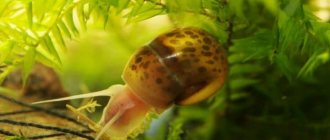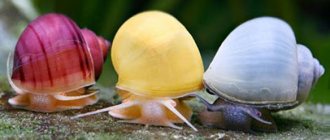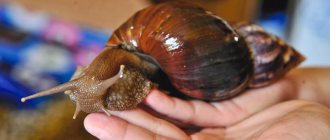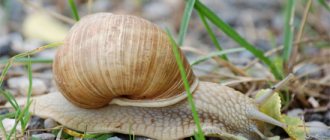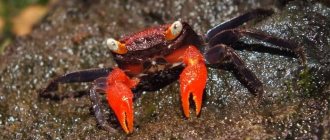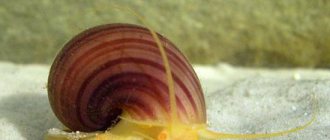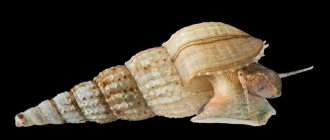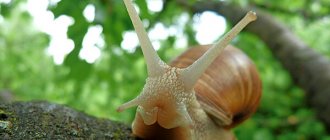Helena is one of the most amazing mollusks in home aquariums. But aquarists keep these beautiful snails with tiger-colored shells not only for the sake of beauty. Their main value is their ability to eat their smaller counterparts. This small predator can control the number of “weedy” mollusks (melania, phys and coils).
- Size: 0.5-1 cm
- Temperature: 23-27⁰С
- Content difficulty: easy
- Behavior: aggressive
- Habitat layer: lower
- gregariousness: gregarious
- Water pH: 7.2-8
- Water type: fresh
Content Features
Despite their unpretentiousness, Helens still need to provide them with suitable living conditions.
Aquarium and water
For a family of 5-10 individuals, a container with a volume of 10-15 liters is suitable.
Of course, if you plan to keep other aquatic inhabitants together with the Helens, the volume of the jar increases. Mollusks of this species are ideal for keeping in a general aquarium or in a herbalist.
If there are a lot of aquatic plants in the water area, then the owner will not have to think about how and what to feed the shellfish - they will begin to eat the remains of fish food and feed on the emerging algae.
Snails of any type (including Helena) require hard water, which contains the mineral substances necessary for the strength of the shells.
Temperature indicators of the aquatic environment should also be monitored:
- if the temperature drops to +20⁰С, Helenas stop reproducing;
- when the regime drops to +18-19⁰C, the mollusks refuse to eat.
Snails need to ensure proper cleanliness of the aquatic environment. Therefore, good aeration and filtration are needed. Jars with Helenas can be decorated with any aquatic plants; snails do not harm them.
Clams absolutely need soil. Helenas burrow into it, as they do in nature, waiting for a victim. For the soil substrate, it is advisable to select small rolled pebbles with a fraction of 2-2.5 mm or coarse sand.
Be sure to cover aquariums with Helena snails; these snails move actively and can crawl out, where without water they quickly die.
Nutritional Features
- Helenas feed on snails, which are considered “weeds.” Coils, acroluxes, fisas, melanias are rapidly multiplying. Helen's presence corrects their balance in the water area and relieves the owner of the jar from manually cleaning small mollusks.
- But Helenas attack only small things; large species (for example, ampullaria) are not touched. They also do not destroy very small snails - Helena’s proboscis is not able to penetrate the contents of the shell.
In their natural habitat, Helenas can also eat carrion (the remains of dead animals that have fallen into the water).
If there are not enough small snails in the aquarium tank, you will have to take care of additional feeding.
Helen's diet includes ready-made bottom tablets for catfish, bloodworms or small frozen shrimp.
Shellfish can be given mussels, boiled squid meat or beef offal (liver, heart).
Helena eats actively, but does not eat every day. And after a hearty meal, it falls into a short hibernation.
With good maintenance and conditions, the life expectancy of these creatures reaches 5 years.
General description and characteristics
Helena snails, photos of which can be seen below, live on the islands of Indochina and Indonesia. This type of mollusk belongs to the only freshwater tubifex, to the family of marine mollusks. In the wild, they live in fast-flowing rivers or in standing bodies of water (lakes). During life, the maximum size is 2 cm.
In the wild they live in rivers
If we consider the description of the shell, then:
- length about 25-30 mm;
- diameter 7 mm.
The difference is the long breathing tube that appears during movement. The shell is ribbed and resembles a cone. The snail has a yellow tint and brown stripes throughout the shell.
Origin and behavior
Helena can be kept at home in freshwater aquariums. In nature, they are found in southeast Asia. Thailand and Indonesia are considered to be the birthplace. It lives in small reservoirs and loves clay or sandy soil.
Helena can be kept at home in freshwater aquariums
They went on sale about 10 years ago. Since then they have gained popularity. They began to spread rapidly. This species was called a killer. Since they are capable of completely exterminating other snails. Mollusks sit in ambush for a long time, waiting for their future victim. So that it is not visible, it buries itself in the ground. When the victim is caught, Helena releases her proboscis and begins to suck the contents of the shell.
External differences
The appearance of hylenas is not similar to other snails. They differ in size, shape, shades, behavior. The structure of the shell resembles a melanium - conical shape. The shade is yellow, there are stripes of a dark brown shade on the shell. The snail moves on a wide flat leg; while moving, you can see a long proboscis.
Habitat
Many snails prefer running water. However, despite this, they can live in lakes and ponds. Helena snails quickly adapt to the aquarium. In natural conditions, the substrate is silt or sandy soil.
Many snails prefer running water
In natural habitats, they prefer to eat small live mollusks and dead fish. It is for this reason that many aquarists get them to fight with coils and fiss. The shell has a conical shape without a pointed tip. The shade is yellow, the stripes are dark brown. Life expectancy is up to 1.5-2 years.
Kinds
Today, there are more than 10 thousand species of snails in nature. About 2 thousand live in Russia. Some species contain poison, the amount of which is quite enough to kill several dozen people (an antidote has not yet been found). Mollusks can be freshwater, marine, or land.
The most popular aquarium snails:
- Ampoules
- Devil's thorn
- Fizy
- Maryse
- Neretina
- Pokemon
- Reels
- Beelines (horned individuals)
- Theodoxuses
- Helena
- Melania
- Black mysteries
If we consider coils, then in an aquarium there are about 5-6 species. Helena is presented in a single copy.
Helen's benefit
The predatory abilities of these mollusks are successfully used by aquarists to adjust the number of small snails, which literally multiply exponentially.
Helenas naturally (biologically) destroy populations of small mollusks. In the absence of Helen, aquarists have to catch snails by hand or use chemicals that:
Negatively affects the health of the fish. Copper, present in chemical preparations, is harmful to fish. This microelement also disrupts the biobalance of the aquarium environment.- They provoke mass mortality of “weedy” snails. The global shellfish pestilence also has a bad effect on the state of water. It becomes polluted with a large amount of dead organic matter and increases the levels of nitrates, ammonia and nitrites. As a result, the owner of the jar has to siphon (clean) the container, filter the water and use zeolite and activated carbon.
Helenas are freed from such efforts and become ideal “cleaners.” Moreover, they do not harm aquatic plants, other large snails, fish, crayfish and shrimp at all.
Feeding
It eats pond snails and cattails more readily, and less readily eats melania due to its relationship with this species.
In addition to small snails, the following are suitable for feeding these carnivores:
- tubifex;
- shrimps;
- bloodworm;
- Artemia;
- mussels;
- plant food with algae;
- beef heart and liver;
- sinking fish food;
- krill.
Having dealt with all the snails, Helena eats the leftover food for the aquarium fish. If the fish's diet contains little protein food, feed the snails Helena. Breed coils or fiss in a separate container so that predators always have food. One medium-sized snail is enough for a couple of days. Chicken eggs are also suitable for feeding.
How to breed snails
Breeding shellfish in a community aquarium is a simple matter that does not require any additional participation from the owner. But get ready for a long process - the breeding procedure for these snails is long.
Helenas are of different sexes, but it is impossible to determine which is female and which is male. Therefore, it is better to select a group of a large number of individuals in advance to increase the chance of obtaining offspring. Sexual maturity of mollusks occurs at the age of six months.
Helenas have been observed to form pairs that stay together all the time.
After mating, the female mollusk lays transparent cubic eggs on the ground, inside of which there is a yellow ball.
The eggs are incubated for 20-30 days. And then the young hatch. Young mollusks immediately burrow into the ground, where they remain for the next 5-6 months.
As soon as their size is 3-5 mm, they appear on the surface. The juveniles begin to swim in the upper water layer and feed on the remains of fish food. Over the course of a year, a pair of Helens brings up to 200-250 new individuals.
Reproduction
At home, predators are easy to reproduce. The first time, as a rule, the amount of caviar is small. Since mollusks are not hermaphrodites, a large population is required to produce offspring. This approach increases the likelihood of a male being present.
At home, predators are easy to reproduce
Often up to 3 individuals can mate at the same time:
- Caviar in appearance resembles a transparent capsule, inside of which you can see a small yellow ball.
- Formation takes from 20 to 30 days and largely depends on the temperature of the water in the aquarium.
- After hatching, the young individuals will not be seen for about 2-2.5 months until they reach a size of 4-5 mm, and will not become live food for other inhabitants.
Successful reproduction is possible only if the temperature is above +20°C.
Suitable neighborhood
Helenas show aggression only towards small “weed” snails. They are indifferent to the other inhabitants of the aquarium. They do not pose a threat to large mollusks - ampularia, neretina or marise. Therefore, they can be kept in a common water area with any types of fish, crayfish, large snails and shrimp. But Helen’s population must be controlled, otherwise there will be no other small snails left in the container.
Helenas can also attack fish. But they do this only in case of illness or severe weakening of the aquarium pet.
Helen can also be kept with large aggressive fish species. True, in this case the snails will refuse to reproduce, and in order to hatch the young, they will have to be placed in a separate jar. Helena can eat aquarium fish eggs herself. Therefore, if it is present in the general water area, for spawning the fish will also have to be transplanted into the spawning area.
The only fish with which Helen is not recommended to live are:
Botsiya
Cichlids
Tetraodons
These predators will attack snails and destroy them.
It is not recommended to immediately place the new Helena with other inhabitants of the jar. The snail must first be quarantined. And keep it separately for 2-3 weeks. This also applies to young snails, which are best placed in an adult aquarium only when they reach 1 cm in height.
Who do they get along with?
As already mentioned, these gastropods are dangerous exclusively for small mollusks. Fish usually do not suffer from them - they are too nimble and active. If, nevertheless, Helena ate such a “neighbor,” then he is most likely already dead or seriously ill.
Shrimp are also not too tough for mollusks, but during molting they are still too vulnerable and can become this predator’s lunch. Therefore, if the owner has obtained particularly rare and unusual specimens for his collection, then it is better to keep them separately from predatory snails.
Since snails are not very picky, they will eat fish eggs if given the opportunity. The slow creature fails to catch frisky fry. When placing predatory mollusks in a common tank, it should be borne in mind that they can not only adjust the population of other snails, but also completely exterminate them, so adjusting the number of individuals still falls on the shoulders of the owner.
Helena is a beautiful snail with a predatory disposition; she performs the work of a “orderly”, eating up the remains of various inhabitants, preventing other small mollusks from overpopulating the aquarium and acting as decoration. It is not surprising that many aquarists prefer them to other representatives of the species.
Adviсe
- To avoid introducing unwanted mollusks and parasites, wash and treat newly acquired plants in a solution of 3% hydrogen peroxide (5 ml per 10 liters of water) or a light pink solution of potassium permanganate. Holding time from 30 min. A weak solution of bleach (25 ml per 1 liter of water) with immersion for 3–5 minutes is also suitable. Remember that not all plants tolerate chlorine; for example, it is harmful to elodea.
- Complete extermination of nurse snails is just as bad as an overgrown population. Gastropods are useful for removing green deposits from glass and loosening the soil, which eliminates oxygen-free zones. Keep an eye on the numbers of predators and prey, or keep helen with large snails like apple snails.
- If the herbivorous snails do not eat the algae, stop feeding them temporarily.
- To prevent water blooms, do not allow sunlight to hit the walls of the aquarium.
Helena has two Latin names: Anentome helena and Clea helena. It is associated with two genera that are of Asian and African origin.
Previous
InhabitantsTricks for keeping a Chinese newt
Next
InhabitantsFeatures of crayfish reproduction in an aquarium
Edentulina obesa
Predatory snails of this species have a second name - green wolf. These mollusks from the Streptaxidae family are native to Tanzania and East Africa. They feed on their own relatives, which include Achatina, slugs and other mollusks.
The diet of these predators does not contain plant foods. In addition, they will not eat beef, pork, chicken, or worms (earthworms, mealworms, etc.).
When two Edentulina obesa snails meet and are vying for the same prey, each of them begins to release foam to scare away the competitor. But after a while the conflict ends, and both mollusks begin to peacefully eat some slug.
Powelliphanta
A predatory New Zealand snail from the family Rhytididae. The earth snail (second name) has 21 species and 51 subspecies. The lifespan is up to 20 years, while there are about 1000 individuals of this predator left on earth.
Powelliphanta feeds on earthworms and slugs, and the size of the shell of this giant can reach 9 cm.
The land snail is nocturnal, spending most of its time in the damp forest floor, under snags and fallen trees.
Predatory snails have their own biological characteristics and requirements for living conditions. They should be thoroughly studied before placing such a mollusk in your home.
5 / 5 ( 4 voices)
Appearance
Helena has bright colors: there are chocolate stripes on her amber-yellow shell. The bright colors indicate that it is predatory. Mollusks most often grow to 15-17 mm, although 20 mm individuals are occasionally found. Their shell is cone-shaped with a ribbed surface. If you look closely at the shell, you can see something resembling a lid on it. Helena closes herself with it after she eats or when danger arises.
Reviews
Helena provides natural control of snail populations in aquariums. The descriptions of aquarists are similar: many at first did not notice how Helena was fighting with mollusks, but within a couple of months the reduction in the number of gastropods was noticeable. It is recommended not to keep too many helenas to maintain a balance of edible shellfish and predators.
